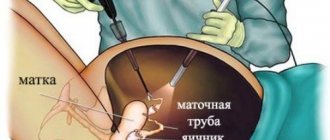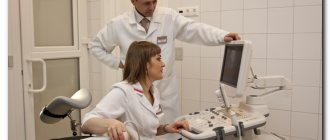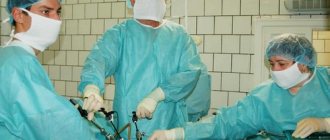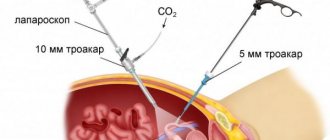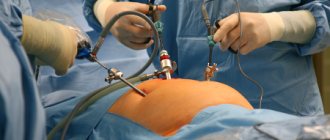Violations of the health of the female reproductive system can cause various problems during conception. One of these pathologies is pregnancy, in which the embryo is implanted in the ectopic cavity, and in the process of its development can lead to dire consequences.
Using modern diagnostic and therapeutic methods, it is possible to minimize the consequences of pathological conception and give a woman a much greater chance of becoming pregnant again. Laparoscopy for ectopic pregnancy saved many patients from the loss of important reproductive organs and the long recovery process after operations.
For what types of ectopic pregnancy is laparoscopy performed?
How is the operation performed?
VB pathology is classified into several types.
- Tubal pregnancy - the fertilized cell cannot travel to the uterus. Due to obstruction, it attaches to the pipe wall, where it begins to develop. It is registered in 97% of patients diagnosed with ectopic pregnancy.
- Abdominal - accidental entry of a wandering zygote into the peritoneal area, where it finds a place for implantation.
- Ovarian pregnancy - at the exit from the follicle, an active sperm is encountered along the path of the egg. After fertilization, it immediately attaches to the wall of the nearest ovary. Such ectopic pregnancy is registered in a maximum of 0.7% of all cases.
- Cervical is a very rare anomaly when the fertilized egg matures in the cervix. It is quickly recognized by the woman’s sensations or during examination.
Any type of ectopic pregnancy can be diagnosed or operated on laparoscopically.
Contraindications
There are a number of contraindications for surgical intervention:
- comatose state of the patient;
- cardiovascular diseases;
- respiratory diseases;
- hernia of the anterior abdominal wall.
In rare cases, laparoscopy is performed for symptoms such as:
- large blood loss into the abdominal cavity - more than 1 liter of blood;
- adhesions on internal organs;
- scars and cicatrices from previous operations;
- obesity.
In this case, laparoscopy can be replaced by laparotomy. In the presence of peritonitis or various infectious diseases, laparoscopy is also contraindicated due to the high risk of possible consequences. Laparoscopy cannot be performed if the fetus is large or if there are malignant neoplasms. Then a laparotomy is performed.
If a woman has a cervical ectopic pregnancy, a circular suture is placed around the cervix, then curettage is performed to preserve the uterus. Curettage can be used for diagnostic purposes if symptoms of pregnancy are present and the fertilized egg is not detected during an ultrasound examination.
How is laparoscopy done?
If a tubal abortion or rupture of the oviduct during an ectopic pregnancy is detected, urgent emergency surgery is required.
Before the manifestation of pronounced signs, a number of preparatory measures are carried out to prevent severe complications and shorten the rehabilitation process.
Recommendations for elective laparoscopy for ectopic pregnancy:
- it is necessary to undergo a detailed examination and pass all prescribed tests;
- on the day before surgery, it is prohibited to eat or drink anything, or to do an enema to empty the bowel;
- It is mandatory to wear compression stockings before and after the procedure.
Performing laparoscopic surgery for ectopic pregnancy:
| Stages | How they do it |
| Preparing the patient | Local anesthesia is performed with connection to an artificial respiration apparatus. The working area is treated with an antiseptic solution. |
| Operation | Three incisions are made - near the navel, on the right and left sides of the iliac region. |
| Expanding the surgeon's freedom of action | A certain amount of carbon dioxide is passed through a Veress needle into the peritoneal area. |
| Introduction of the laparoscope | An optical device with a camera and lighting is inserted through the umbilical opening, and additional trocars are inserted through other incisions. |
| Identifying the cause | Each organ of the pelvis and peritoneum is carefully examined. |
| Elimination of pathology | Surgery is performed to remove or preserve the tube. |
| End of operation | After all the manipulations, the formed blood clots are eliminated and the pelvic organs are washed. |
| Control measures | A re-inspection is carried out to eliminate defects. |
| Completion | Instruments are removed from the abdominal cavity, sutures are placed on the incisions, and gas is released from the abdomen. The woman is disconnected from the machine and taken out of anesthesia. |
Duration of laparoscopy
Single tube laparoscopy for ectopic pregnancy has the following advantages:
- the duration of the procedure is 15-60 minutes, depending on the complexity of the clinical case;
- surgery for an ectopic pregnancy does not result in great stress for the patient;
- blood loss after the procedure is minimal;
- there is no need for large dissections of the peritoneum, which require long-term scarring of the suture, the incisions are so small that later traces of the intervention are practically invisible;
- the risk of formation of adhesions of the fallopian tubes after ectopic pregnancy is minimized;
- the rehabilitation period is reduced;
- the procedure can be performed for both treatment and preventive purposes.
The main advantage is that after laparoscopy with preservation of the tube during an ectopic pregnancy, a woman has a great chance of conceiving naturally.
Recommendations after surgery
Regardless of what type of surgical intervention was performed to get rid of an ectopic pregnancy, to stabilize the functions of the reproductive system, it is necessary to carry out drug therapy, as well as physical therapy.
One of the irreplaceable types of physiotherapy is magnetic therapy - it has a strong anti-inflammatory effect and prevents the formation of adhesions. Magnetic therapy helps maintain the functioning of the tube at the proper level, and this is very important especially in the case when the patient was left alone after the operation and there was severe bleeding.
Therapy after ectopic conception can take a long time. An important point is contraception, since you should abstain from subsequent pregnancy for at least six months for complete restoration of the genital organs.
To restore the patency of the fallopian tubes and prevent difficulties with conception, it is necessary to undergo a rehabilitation process, which, in addition to physical therapy, includes taking anti-inflammatory and anti-adhesive medications.
Of course, the possibilities of modern medicine in the form of laparoscopy give a woman a much greater chance of successfully becoming pregnant after an ectopic pregnancy. Thanks to new surgical techniques that ensure almost 90% preservation of the tubes, the level of infertility and the risk of repeated conceptions outside the uterus are significantly reduced. Even women who, as a result of ectopic conceptions, are left without both fallopian tubes should not despair, because they can become pregnant using in vitro fertilization and carry a healthy baby.
When is diagnostic laparoscopy needed?
The endoscopic examination method is a common procedure classified as minor surgical operations.
The endocamera of a laparoscope inserted into the abdominal cavity has the ability to show all movements of the device. The video is broadcast on a color monitor at 6x magnification of organs and internal processes.
This is what a laparoscope endocamera looks like
Laparoscopic diagnosis is performed during a routine examination or as an emergency measure to understand the clinical condition of the patient.
Indications for endoscopy for ectopic pregnancy:
- clarification of the diagnosis of ectopic conception;
- with severe or unexplained pain in the peritoneal area;
- if a biopsy is necessary, cutting off a piece of tissue to identify inflammatory processes;
- if you suspect the formation of a cyst, fibroma, tumor in the pelvic organs;
- to identify and eliminate adhesions on the fallopian tubes;
- elimination of foci of endometriosis;
- if organ apoplexy or the development of an acute condition is suspected.
Typically, diagnostic laparoscopy is performed to confirm or establish an accurate diagnosis if an ectopic pregnancy is suspected. Often the examination turns into therapeutic manipulations.
Possible complications
Side effects of this safe procedure are minimized. However, in addition to the appearance of pathological discharge, a woman may experience other symptoms:
- temperature increase;
- general weakness and fatigue;
- loss of consciousness;
- decreased appetite;
- bloating;
- frequent urge to empty the bladder;
- nausea, even vomiting;
- increased pain in the abdomen;
- swelling and hyperemia of suture areas;
- bleeding from wounds;
- pneumonia;
- stroke.
To relieve pain, painkillers are prescribed; medications containing Simethicone can eliminate flatulence. At the end of all the above information, I would like to add that in order to avoid all the unpleasant manifestations of the postoperative period, the patient must follow all the recommendations of the attending physician. In addition, approach the choice of a medical institution and specialist who will perform laparoscopy with all responsibility. And if all the rules of the rehabilitation period are followed, the woman will quickly return to her previous shape and active life without consequences for her health.
In gynecological practice, laparoscopy is not the last place. Thanks to this method of conducting operations, it became possible to minimize the trauma of interventions and speed up the recovery of women. As a rule, recovery after surgery is quick and proceeds without complications. In some cases, discharge is observed after laparoscopy, which can be both a sign of normality and pathology.
With preservation of the pipe
The popularity of laparoscopy is explained by the fact that the principle of the method technology belongs to the category of organ-preserving operations for ectopic pregnancy.
It is rarely possible to save a pipe
Indications for intervention are the following factors:
- implantation in the isthmic or ampullary part of the organ;
- pipe increase no more than 4 - 5 cm;
- early stage of ectopic pregnancy up to 4–5 weeks.
Varieties of laparoscopy methods with tube preservation.
- Tubotomy (or salpingotomy) - the embryo is removed by cutting the tube wall. Surgery for ectopic pregnancy has a high probability of restoring all functions of the organ.
- Segmental resection of the tube - removal of the damaged section of the oviduct with the possibility of subsequent plastic surgery.
- Milking (or squeezing) is used very rarely when diagnosing trophoblast detachment.
It is worth considering that the gentle operation of laparoscopic tubotomy helps to preserve the tube in the early stages of detecting an ectopic pregnancy.
A woman needs to observe all changes in her body. This will allow you to consult a doctor in a timely manner and quickly identify an ectopic pregnancy.
Pregnancy outside the uterus
When the fetus begins to develop in places other than the uterus, it is called an ectopic (ectopic) pregnancy. The embryo is localized in the lumen of the tube, on the ovaries, cervix or liver, spleen, and intestines. The most common type of ectopic pregnancy (EP) is tubal - the formation and development of the fetus in the fallopian tube.
As a result of improper location of the egg and its development, tissue injury occurs and bleeding occurs, accompanied by pain. Characteristic symptoms of ectopic pregnancy are:
- delay of menstruation;
- periodic bleeding that does not resemble menstruation;
- long (protracted) menstruation;
- pallor of the skin.
Symptoms include dizziness or fainting. Many women in early pregnancy may not be aware of fertilization, so if the symptoms described above appear, you should immediately visit a gynecologist.
The reasons for the development of an embryo outside the uterine cavity are different. These include:
- pathology of the structure of the internal genital organs;
- chronic and inflammatory diseases;
- venereal and fungal diseases of the genital organs;
- mechanical injuries after conception.
Also, ectopic pregnancy can occur against the background of excessive physical activity, lifting heavy objects and nervous stress. But the most common causes of ectopic pregnancy are chronic inflammatory processes of the reproductive organs.
With pipe removal
This is what the oviduct looks like
If there are significant changes in the oviduct, it is impossible to perform organ-preserving surgery. Factors that serve as indications for laparoscopy with elimination of the fallopian tube during ectopic pregnancy.
- Rupture of the wall of the oviduct, when damage to a large area is observed.
- Hyperemia and cyanosis of the tube during ectopic pregnancy with damage to almost all layers of the membrane.
- There is a danger of bleeding when performing coagulation of the attachment site of a fertilized zygote.
- Previous surgery on this tube with a similar diagnosis.
How much does laparoscopy cost?
The cost of laparoscopy in the presence of an ectopic pregnancy depends on:
- complexity of the clinical situation;
- volume of performed manipulations;
- the chosen procedure technique;
- preservation or removal of pipes and other organs.
The cost is influenced by the level of the medical institution, the class of equipment, the qualifications of the medical staff and the region. For example, in Moscow, prices for laparoscopy for ectopic pregnancy range from 10 to 200 thousand rubles and more. In Yaroslavl they reach 100 thousand, and in Novosibirsk up to 50.
Recovery period
Rehabilitation takes from 2 months
If there are no complications after laparoscopy and the patient is in good health, rehabilitation usually proceeds quickly.
The following signs are considered normal:
- during the first hours, mild painful sensations are possible;
- an increase in low-grade body temperature is allowed;
- the appearance of bloody discharge.
How long they stay in the hospital depends on the patient’s condition and the absence of clinical symptoms. The average duration of the postoperative period for ectopic pregnancy is 10–14 days. A full course of rehabilitation after laparoscopy, including the entire range of rehabilitation measures, lasts no more than a month.
It can be divided into three stages.
- The first day - until the anesthesia has completely worn off, it is recommended to lie down; in the evening, more active movements are allowed, drinking is allowed.
- Treatment in a hospital - you need to be under constant medical supervision for about a week. Discomfort and soreness may continue for some time due to carbon dioxide residues in the abdominal cavity. The sutures are removed approximately on day 5.
- Home care includes physical and antibiotic therapy, diet, and following doctor’s orders. The postoperative period after laparoscopy requires the patient to adhere to the diet and quality of nutrition, giving up bad habits in order to exclude ectopic pregnancy during the next conception.
How to remove the fallopian tube by laparoscopy
Let's look at the tubectomy technique, or how the fallopian tube is removed by laparoscopy.
During the operation, the patient should be in the Trendelenburg position - lying on her back, then the pelvis should be elevated by 45 degrees - this is the most optimal position for the patient for surgical treatment on the pelvic organs. After applying pneumoperitoneum, a thorough examination of the uterus and appendages is carried out, and the scope of surgical intervention is determined. The fallopian tube, which is decided to be removed, is clamped with special jaws from the side of the uterus, as close as possible to the cutting site, stretched and cut off. At the same time, coagulation is carried out. Coagulation is required to prevent bleeding. Then the upper part of the broad ligament of the uterus and the isthmus of the fallopian tube are separated and coagulated. The next step is to apply ligatures. The severed fallopian tube is removed through the largest trocar, its diameter is 11 mm. How long laparoscopy to remove the fallopian tube lasts is determined individually, it depends on the technical difficulties of the operation, however, on average, the operation takes no more than 30 minutes, but deviations in time are possible due to the characteristics of anesthesia and the occurrence of complications.
Discharge after laparoscopy
Carrying out surgery for ectopic pregnancy requires monitoring all your sensations or changes in the body. Internal injuries to the genitals can cause vaginal discharge.
To understand whether an inflammatory process develops or not after laparoscopy, you need to pay attention to their nature, abundance and general well-being.
- Minor, odorless spotting is allowed in the first few days or weeks after surgery. Gradually they become ichorous, and then mucous, reminiscent of leucorrhoea without changing consistency.
- Cloudy, yellowish or green discharge accompanied by a foul odor is a sign of infection. You must visit a doctor immediately.
- Brown discharge without additional symptoms is considered normal. If the stomach hurts, the temperature rises, an unpleasant odor, weakness and fever appear, then these are signs of the development of an inflammatory process.
In case of dangerous symptoms, the doctor will prescribe a follow-up examination and laboratory tests, based on the results of which appropriate measures will be taken.
Sometimes taking prescribed antibiotics leads to disruption of the vaginal microflora. As a result, white cheesy discharge occurs, which is accompanied by itching and redness of the mucous membranes of the genital organs.
Scars that will remain
This is a sign of the development of candidal colpitis (popularly thrush). Treatment is carried out with vaginal suppositories or antifungal drugs.
General recommendations for recovery
After surgery, women need not only physical rehabilitation, but also psychological support. Hormonal imbalance is the most common problem that provokes the development of various ailments (insomnia, irritability, emotional lability, nervousness, engorgement of the mammary glands, problems in sexual life, irregular periods).
Diet
The first day after laparoscopy you must refrain from eating. Only still water is allowed. On days 2-4, foods that are easily absorbed by the body are introduced into the diet:
- Low-fat kefir;
- Plain yogurt;
- Crackers;
- Vegetable or light meat broth;
- A small amount of lean boiled meat or fish;
- Porridge.
Gradually, the menu can be enriched with new food products. Returning to normal eating behavior depends on the patient’s well-being.
Physical exercise
For the first 2-3 weeks, patients are not allowed to exercise or stress the body in any other way. The return to an active lifestyle involving physical activity occurs gradually, but not earlier than a month after surgery.
Sexual contacts
Sexual intercourse after radical intervention can be resumed no earlier than 2 weeks later. The woman should feel well, and there should be no complications recorded in the anamnesis.
You can plan a pregnancy 6–7 months after undergoing laparoscopy. Ideally, the interval between two conceptions should be 1–2 years. For the last six months, women have been advised to take oral contraceptives. This will completely restore the neuroendocrine function of the body, stabilize the emotional background and reproductive functionality of the woman.
Bleeding
Bright red discharge after surgery for ectopic pregnancy, which comes out with clots, while no tendency to decrease is observed - this is a sign of a pathological manifestation.
If additional symptoms of increased weakness, tachycardia or dizziness are present, the condition is interpreted as life-threatening. That is, the situation requires urgent medical intervention.
Despite careful observation, when inserting a laparoscope during an ectopic pregnancy, there is always a risk of damage to the integrity of the blood vessels, stomach, walls, etc.
In the event of a puncture of any organ, bleeding occurs, to stop which an operation is required to suturing the injured area.
Advantages of the technique
If the pain is severe, you should immediately seek medical help.
Laparoscopic intervention is a minimally invasive and highly effective surgical treatment method. The procedure has many advantages. Firstly, thanks to the use of an optical system during laparoscopic surgery, the specialist clearly sees the area of the operation with multiple magnification. Secondly, with laparoscopy, blood loss is minimal, since there are no cuts or tissue damage, except for minor punctures.
This is also associated with the absence of injuries, because during the laparoscopic intervention there is no contact with all kinds of tampons or the surgeon’s hands. After the operation, the hospital stay lasts only a few days. There are no sensations characteristic of abdominal operations, for example, painful distension of the abdominal cavity, etc. Since there are no incisions during laparoscopy, there will be no postoperative scars either, only slightly noticeable puncture marks.
Minimal risks of developing postoperative complications, short rehabilitation periods, the possibility of combining diagnostic, surgical and preventive procedures - all this also gives the laparoscopic method of treating ectopic ectopic diseases significant advantages.
Periods after tube removal
Cycle recovery after 30 days
The onset of the first menstruation after the procedure depends on the physiological characteristics of the body. Cases of prolonged absence or premature heavy bleeding due to tube removal are equally observed.
As a rule, menstruation occurs with a slight delay after tubal laparoscopy due to ectopic pregnancy. Normal recovery of the cycle occurs within 25–40 days. Often the reason for the delay is the woman’s severe psychological state caused by the stress suffered from the loss of a child.
If restoration of menstrual function after laparoscopy for ectopic pregnancy and tube removal does not occur within 2 to 3 months, then the patient is prescribed a course of hormone therapy.
Rehabilitation after the study
Laparoscopy does not lead to serious consequences. Complications are extremely rare. The postoperative period is quick and easy due to low trauma and the absence of large incisions.
The rehabilitation course lasts no more than 3-4 days. Patients quickly recover and are discharged home. The sutures heal and intestinal function is restored.
Of course, in the first months you should take care and protect yourself from heavy physical labor and heavy lifting. You can't neglect your diet. It is worth excluding carbonated drinks and fried foods that increase gas formation. It’s better to sit for a while on light soups and porridges.
Women are not recommended to sit in one place for a long time. It is better to walk more often after the operation, which, on the contrary, will promote rapid tissue healing, eliminate intestinal problems, blood clots in the veins in the legs and other complications.
How much sick leave after laparoscopy?
The duration of the postoperative period for ectopic pregnancy depends on the clinical picture and condition of the patient. An important fact is how hard the woman’s body endured the laparoscopy procedure, whether the tube was removed or not.
How many days they stay in the hospital is determined by the doctor. Typically, the patient is discharged 5–7 days after surgery to undergo further outpatient treatment.
Discharge in 5-7 days
A sick leave is issued for a maximum of 15 days, to extend which you will need to undergo a medical commission. When sent home after laparoscopy, the woman is given recommendations on caring for sutures, intimacy, personal hygiene, diet, limiting physical activity and taking medications.
Reviews
For patients who have undergone an operation such as laparoscopy to remove the fallopian tubes, reviews may be contradictory. This may be due to the fact that each organism has its own characteristics of adaptation after surgical treatment. Basically, reviews of laparoscopy and tubectomy contain specific experiences of patients; they may contain information about the duration of the operation, methods of pain relief, and the course of the postoperative period. According to numerous reviews, the operation is relatively easy, rehabilitation proceeds without difficulties, and complications are rare. If the patient is interested in removal of the fallopian tube, laparoscopy and its consequences, reviews will help summarize theoretical information and draw some conclusions about the feasibility of the operation and postoperative risks. Thus, after studying many reviews, it becomes clear that statistically the percentage of complications is extremely small and is more often associated with the presence of concomitant pathology. For example, disorders in the neuro-endocrine sphere more often occur in women, who in reviews indicate existing hormonal dysfunction. Also, based on reviews, one can be convinced that the consequences for fertility after tubectomy are not fatal, and removal of the fallopian tubes in many cases significantly increases the success of assisted reproductive technologies. Many women, having gone through several attempts at IVF, after tubectomy achieve success after the first IVF protocol after surgery. If a patient is about to undergo fallopian tube removal and laparoscopy, reviews can sometimes form an erroneous opinion about the difficulties after the operation, since sometimes these difficulties may not bother a particular patient, but set her up for an obviously negative result. Therefore, you should understand that the operation does not always go as in someone else’s review, and you should rely on the experience and knowledge of your attending physician, who knows all the characteristics of a particular patient.
What can you eat
During the first day after surgery for ectopic pregnancy, only drinking non-carbonated mineral water is allowed. Then gradually include easily digestible foods in the diet in small portions with a frequency of up to 6–7 times a day.
What to eat after laparoscopy of ectopic pregnancy to reduce the risk of complications:
- lean broth;
- jelly on fruits or berries;
- jelly or compote, weak tea, diluted juice;
- herbal decoctions;
- after three days, porridge is introduced (oatmeal, buckwheat, rice);
- then include pureed meat or fish products, but only boiled or steamed;
- cottage cheese mixed with low-fat cream;
- bread is replaced with crackers.
The doctor regulates the diet after laparoscopy based on the patient’s well-being. In their reviews on forums, women note that a gentle diet allows you to quickly restore the menstrual cycle and organ function.
Fertilization is a miracle
Consequences
Considering that restoration of the fallopian tubes after their radical removal is impossible, the main consequence of such an operation for the body is a decrease or limitation of reproductive function. If removal of one fallopian tube is required, laparoscopy and its consequences are not so drastic; conception naturally is possible with normal functioning of the second tube. If both fallopian tubes have been removed, then getting pregnant is possible only through in vitro fertilization.
Among the possible consequences, one can also note menstrual irregularities, which, however, are temporary and are subject to hormonal correction. Manifestations of disorders of the neuro-endocrine system are also possible - hot flashes, sweating, palpitations, pain in the mammary glands, thyroid dysfunction. These manifestations are usually characteristic only of the early period of adaptation of the body and are short-lived. The risk of such complications increases slightly with bilateral tubectomy.
If a woman has to undergo fallopian tube removal and laparoscopy, the consequences should be discussed with the attending physician so that their occurrence later is not unexpected.


